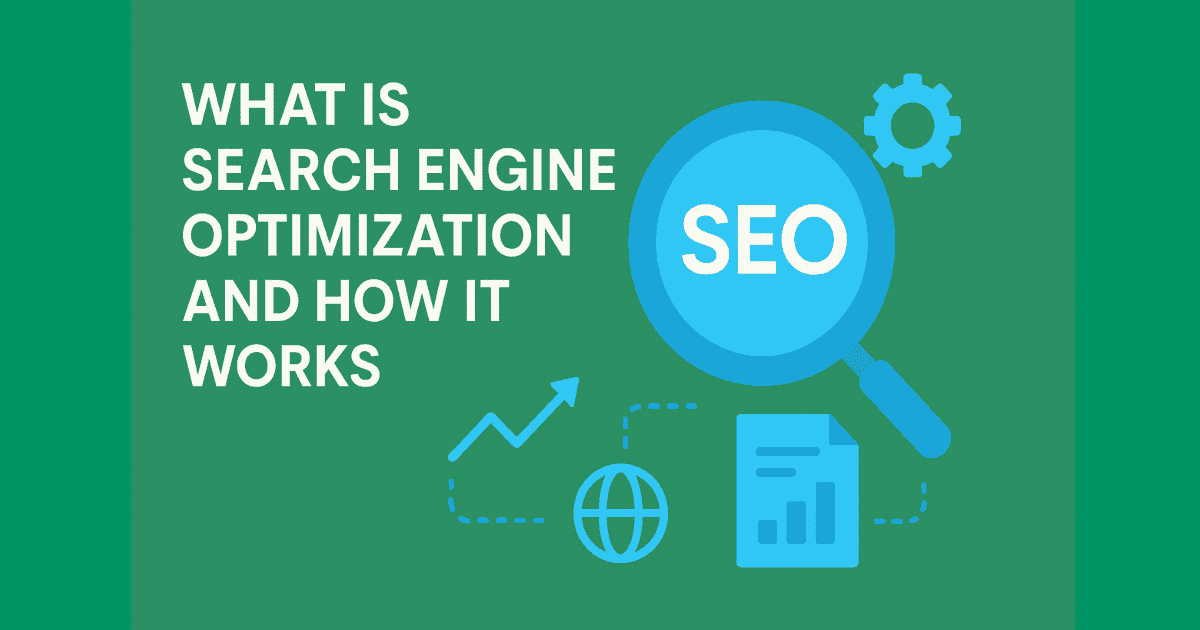SEO means Search Engine Optimization, the process of getting free, organic traffic from search results by making your website easier to find. Learn more.
In today’s digital world, simply having a website isn’t enough to attract customers. With millions of sites competing for attention, your business needs a strategy to stand out. That’s where Search Engine Optimization (SEO) comes in. SEO is the process of improving your website’s visibility on search engines like Google so that when people search for products or services you offer, your website appears higher in the results. The better your ranking, the more traffic, leads, and sales you can generate.
In this article, we’ll break down what SEO is, how it works, its main components, and why it’s crucial for businesses in 2025.
What Is Search Engine Optimization?
Search Engine Optimization (SEO) is the practice of enhancing your website to increase its visibility when people search for keywords related to your business. The goal is to rank higher on search engine results pages (SERPs), attract more organic (non-paid) traffic, and ultimately grow your online presence.
SEO is not a one-time task—it’s a continuous process that involves strategy, content, and technical improvements.
How Search Engines Work
To understand SEO, it’s important to know how search engines like Google work. They use three key steps:
-
Crawling – Search engines use bots (also called crawlers or spiders) to scan the internet for new or updated content.
-
Indexing – Once a page is crawled, it’s stored in the search engine’s index—a massive database of web pages.
-
Ranking – When a user types a query, search engines use complex algorithms to rank pages in order of relevance and quality.
Your website’s position in search results depends on how well it meets Google’s ranking factors.
Why SEO Matters for Businesses
SEO helps businesses in many ways, such as:
-
Increased visibility and traffic – Higher rankings mean more potential customers.
-
Better credibility and trust – Websites that rank on the first page are often seen as more trustworthy.
-
Cost-effective marketing – Unlike paid ads, organic traffic doesn’t stop when your ad budget runs out.
-
Long-term results – Good SEO builds a strong foundation for sustainable growth.
Key Components of SEO
SEO can be divided into several core areas:
a. On-Page SEO
On-page SEO focuses on optimizing the content and structure of your website. Key elements include:
-
Using relevant keywords naturally in titles, headings, and content
-
Optimizing meta tags (title and description)
-
Creating high-quality, valuable content
-
Internal linking between pages
-
Ensuring mobile-friendliness and fast page speed
b. Off-Page SEO
Off-page SEO involves activities outside your website that help boost rankings. This includes:
-
Backlink building – Earning links from other trusted websites
-
Social signals – Engagement on social media platforms
-
Brand mentions – References to your business across the web
c. Technical SEO
Technical SEO ensures that search engines can easily crawl and index your site. It includes:
-
Creating an XML sitemap
-
Fixing broken links and redirects
-
Improving site speed
-
Implementing HTTPS for security
-
Optimizing site architecture
Keyword Research: The Foundation of SEO
Keywords are the words or phrases users type into search engines. Effective SEO starts with identifying the right keywords for your audience.
There are three types of keywords:
-
Short-tail keywords (e.g., “SEO”) – High search volume but very competitive.
-
Medium-tail keywords (e.g., “SEO services USA”) – Moderate volume and competition.
-
Long-tail keywords (e.g., “affordable SEO services for small businesses”) – Lower volume but more targeted.
Using tools like Google Keyword Planner or Ahrefs can help you find valuable keywords to target.
How Content Impacts SEO
Content is at the heart of SEO. Search engines want to provide users with the most relevant and helpful information. By creating valuable blog posts, guides, videos, and infographics, you increase your chances of ranking higher.
Great SEO content should:
-
Answer the user’s query clearly
-
Include relevant keywords naturally
-
Be well-structured and easy to read
-
Be original and regularly updated
Link Building and Authority
Links from other reputable websites act as “votes of confidence” for your site. The more high-quality backlinks you earn, the more authority your website gains in the eyes of search engines.
Some effective link-building methods include:
-
Guest blogging
-
Creating shareable content
-
Collaborating with influencers
-
Earning mentions in online publications
SEO Tools and Analytics
Monitoring your SEO performance is essential. Popular tools include:
-
Google Analytics – Tracks website traffic and user behavior.
-
Google Search Console – Shows how your site performs in Google search.
-
SEMrush, Ahrefs, Moz – Provide keyword tracking, backlink analysis, and competitor research.
Regular analysis helps refine your strategy and achieve better results over time.
How Long Does SEO Take to Work?
Unlike paid ads, SEO doesn’t deliver instant results. It usually takes 3 to 6 months to start seeing noticeable improvements, depending on competition, website age, and strategy. However, once rankings improve, the benefits are long-lasting and more cost-effective over time.
SEO Best Practices for 2025
SEO is constantly evolving. To stay ahead, follow these best practices:
-
Focus on user experience and fast-loading pages.
-
Optimize for voice search and conversational keywords.
-
Use structured data (schema markup) to help search engines understand your content.
-
Keep your content fresh and regularly updated.
-
Build genuine relationships for quality backlinks rather than spammy tactics.
Conclusion
Search Engine Optimization is one of the most powerful ways to grow your online presence. By understanding how SEO works and applying the right strategies, businesses can attract more visitors, build trust, and achieve long-term success.
Whether you’re a small business or a large enterprise, investing in SEO in 2025 is essential for staying competitive in the digital landscape.


